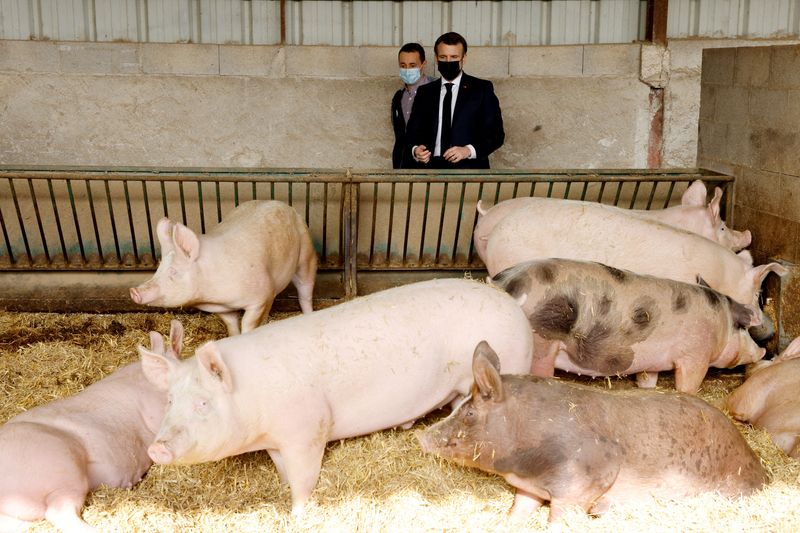By Gus Trompiz
PARIS (Reuters) - Record pig prices could have spurred farmers like Carole Joliff to expand their herd, but costly livestock regulations, flagging demand and spreading swine disease point instead to a long-term decline in the European Union, the world's top pork exporter.
"We're flying blind," Joliff, who farms in France's pig-breeding heartland of Brittany, said. "We'd like to invest but we don't know where we're heading."
Pig prices soared in Europe last year as output was cut by farms squeezed by high grain and energy costs.
Unlike previous cycles, European breeders are in no rush to revive production despite record prices this year that have restored margins for many farms.
European Union pork production is set to fall for a second year in 2023, taking the cumulative decline to around 10%, and output could ebb further in the coming years, according to analysts.
"It's a structural shift," said Jean-Paul Simier, a meat analyst and contributor to French commodities review Cyclope. "It's a dis-intensification of European production."
The EU pork industry has been buffeted in the past decade by a Russian trade embargo, the westward spread of African swine fever and the COVID-19 pandemic. After rebounding from these crises, helped by bursts of Chinese demand, pressures on European producers appear to be coming to a head.
Farmers fear an overhaul of EU livestock regulations, which may phase out cages and extend industrial pollution limits to more farms, will cost billions and price EU pork out of export and domestic markets.
The potential impact of the changes, due to be finalised in the year ahead, is unclear as EU states tussle with a European Commission keen to progress on sustainability goals.
German agricultural research institute EuroCARE and Hungarian counterpart AKI, in a study for EU farming group Copa-Cogeca, estimate that ending sow stalls swiftly by 2025 would cut pork production by nearly a quarter and raise prices by almost half, compared with 8% and 11% variations, respectively, in a longer transition to 2035.
Whatever the final regulations, analysts expect the industry to reflect a society focus on animal welfare and environmental protection.
"We're continuing to add costs to the overall pork production chain," Justin Sherrard, global strategist for animal protein at Rabobank, said. "It's reasonable to see a decline in volumes over 5-10 years."
HIGHER PRICES, LOWER EXPORTS
Germany's pork sector has already shrunk, hurt by an outbreak of African swine fever (ASF) that slashed exports from 2020 as key markets like China and Japan closed their doors.
Pork output from Germany's slaughterhouses fell almost 10% last year, accelerating the drop since 2016 to nearly 20%, according to the national statistics office.
The German industry has also been under pressure to improve working practices and is faced with a steep decline in meat-eating, with per capita pork consumption falling by a quarter between 1997 and 2022, according to state food agency BLE.
Other major producing countries in the EU have been untouched by ASF so far or seen pork demand hold up better, but are still experiencing a production decline.
In export-focused Denmark, the pig herd is its smallest in 25 years, with Klaus Kaiser of agrifood research institute Seges noting that farm profitability has yet to recover.
In the Netherlands pig numbers have fallen 9% in the past five years as the government pursues a push to limit nitrogen emissions from livestock farms.
Spain's output has been less affected, partly benefiting from Germany's loss of export trade. But rising costs and the impact of another swine disease outbreak have also curbed pig production there since last year.
The effects are being felt down the pork production chain. Danish Crown announced in April the closure of a major slaughterhouse due to overcapacity, while several German meatpacking plants plan to close or cut capacity.
In France, 17 small pork processors are in court proceedings due to financial difficulties as they struggle to pass on high costs to retailers baulking at food inflation, industry group FICT said.
In exports, uncompetitive prices and lower output in the EU are leaving more space for suppliers in Brazil and United States to capture slower demand from China.
That may mean EU pork exports, whose share of production more than doubled to 21% between 2000 and 2020, have peaked.
"Europe will be less focused on global export markets," Rabobank's Sherrard said.
Domestically, pork remains cheaper than beef or lamb, and specialities like bacon, jamon serrano and prosciutto are still favourites for many households.

But an inflationary economy may make consumers less ready to accept rising pork prices and deepen a shift towards chicken as a cheaper, more convenient option.
"The outlook for pig farming in Germany and the EU generally is not good," said Tim Koch, meat analyst at German consultancy AMI.